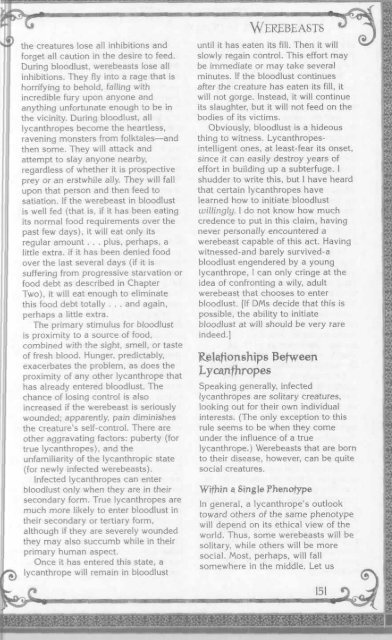Van Richten's Monster Hunter's.pdf - Askadesign.com
Van Richten's Monster Hunter's.pdf - Askadesign.com
Van Richten's Monster Hunter's.pdf - Askadesign.com
You also want an ePaper? Increase the reach of your titles
YUMPU automatically turns print PDFs into web optimized ePapers that Google loves.
.<br />
'.' the creatures lose all inhibitions and<br />
forget all caution in the desire to feed.<br />
During bloodlust, werebeasts lose all<br />
inhibitions. They fly into a rage that is<br />
horrifying to behold, falling with<br />
incredible fury upon anyone and<br />
anything unfortunate enough to be in<br />
the vicinity. During bloodlust, all<br />
lycanthropes be<strong>com</strong>e the heartless,<br />
ravening monsters from folktales-and<br />
then some. They will attack and<br />
attempt to slay anyone nearby,<br />
regardless of whether it is prospective<br />
prey or an erstwhile ally. They will fall<br />
upon that person and then feed to<br />
satiation. If the werebeast in bloodlust<br />
is well fed (that is. if it has been eating<br />
its normal food requirements over the<br />
past few days), it will eat only its<br />
regular amount . , . plus, perhaps, a<br />
little extra. If it has been denied food<br />
over the last several days (if it is<br />
suffering from progressive starvation or<br />
food debt as described in Chapter<br />
Two), it will eat enough to eliminate<br />
this food debt totally . . . and again,<br />
perhaps a little extra.<br />
The primary stimulus for bloodlust<br />
is proximity to a source of food,<br />
<strong>com</strong>bined with the sight, smell, or taste<br />
of fresh blood. Hunger, predictably,<br />
exacerbates the problem, as does the<br />
proximity of any other lycanthrope that<br />
has already entered bloodlust. The<br />
chance of losing control is also<br />
increased if the werebeast is seriously<br />
wounded; apparently, pain diminishes<br />
the creature's self-control. There are<br />
other aggravating factors: puberty (for<br />
true lycanthropes), and the<br />
unfamiliarity of the lycanthropic state<br />
(for newly infected werebeasts).<br />
Infected lycanthropes can enter<br />
bloodlust only when they are in their<br />
secondary form. True lycanthropes are<br />
much more likely to enter bloodlust in<br />
their secondary or tertiary form,<br />
although if they are severely wounded<br />
they may also succumb while in their<br />
primary human aspect.<br />
Once it has entered this state, a<br />
3 lycanthrope will remain in bloodlust<br />
LYERLEEASE<br />
until it has eaten its fill. Then it will<br />
slowly regain control. This effort may<br />
be immediate or may take several<br />
minutes. If the bloodlust continues<br />
after the creature has eaten its fill, it<br />
will not gorge. Instead, it will continue<br />
its slaughter, but it will not feed on the<br />
bodies of its victims.<br />
Obviously, bloodlust is a hideous<br />
thing to witness. Lycanthropes-<br />
intelligent ones, at least-fear its onset,<br />
since it can easily destroy years of<br />
effort in building up a subterfuge. I<br />
shudder to write this, but I have heard<br />
that certain lycanthropes have<br />
learned how to initiate bloodlust<br />
willingly. I do not know how much<br />
credence to put in this claim, having<br />
never personally encountered a<br />
werebeast capable of this act. Having<br />
witnessed-and barely survived-a<br />
bloodlust engendered by a young<br />
lycanthrope, 1 can only cringe at the<br />
idea of confronting a wily, adult<br />
werebeast that chooses to enter<br />
bloodlust. [If DMs decide that this is<br />
possible, the ability to initiate<br />
bloodlust at will should be very rare<br />
indeed.]<br />
RelafionsF.ips Between<br />
L y canthopes<br />
Speaking generally, infected<br />
lycanthropes are solitary creatures,<br />
looking out for their own individual<br />
interests. (The only exception to this<br />
rule seems to be when they <strong>com</strong>e<br />
under the influence of a true<br />
lycanthrope.) Werebeasts that are born<br />
to their disease, however, can be quite<br />
social creatures.<br />
W+hin 4 Si~gle<br />
Phenotype<br />
In general, a lycanthrope's outlook<br />
toward others of the same phenotype<br />
will depend on its ethical view of the<br />
world. Thus, some werebeasts will be<br />
solitary, while others will be more<br />
social. Most, perhaps, will fall<br />
somewhere in the middle. Let us<br />
.*.A


